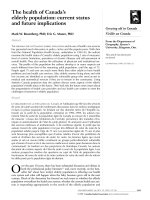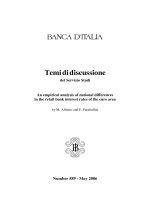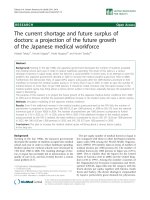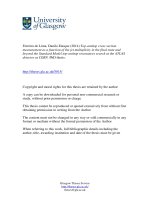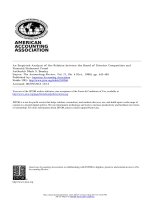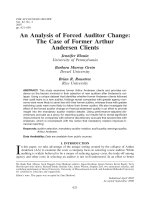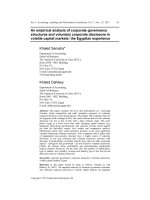An archival analysis of green information technology the current state and future directions
Bạn đang xem bản rút gọn của tài liệu. Xem và tải ngay bản đầy đủ của tài liệu tại đây (549.51 KB, 133 trang )
AN ARCHIVAL ANALYSIS OF GREEN
INFORMATION TECHNOLOGY: THE CURRENT
STATE AND FUTURE DIRECTIONS
A Thesis Submitted
In Fulfilment of the Requirements
for the Degree of Masters by Research
(Information System- IT60)
Bonny Tuskeen Tushi
Bachelor of Commerce (Accounting)
Diploma on Business Administration
Supervisor: Dr Darshana Sedera
Dr Sharmistha Dey
Information Systems
Science and Engineering Faculty
Queensland University of Technology
2015
Keywords
Archival
Analysis,
Green
Information
Technology,
Green,
Environment,
Technology, Systems Information Technology, Information Systems
An Archival Analysis OF Green Information Technology: The Current State and Future Directions
i
Abstract
Research on Green Information Technology (IT) is becoming a prevalent research
theme in Information Systems (IS) research. This research provides a review of 199
papers published on Green IT/IS between 2007−2014. Our paper selection is unique,
as we synthesize papers from three disciplines: Computer Science, Information
Systems and Management. The research presents taxonomy of segments in Green
IT/IS publications, where the segments are later used for multiple analyses to
facilitate future research and to provide a retrospective analysis of existing
knowledge and gaps thereof. While some researchers have discussed phenomena
such as Green IT, motivation of Green IT and the Green IT adoption lifecycle, others
have chosen to focus on the importance of Green IT implementation at the
organisational and individual level. Throughout the literature, scholars try to portray
a constructive relationship between IT/IS and the environment.
This research also attempts to make a unique contribution to our understanding of
Green IT/IS, by consolidating papers it observes current patterns of literature through
approach analysis and segmentation, as well as allocating studies to the technology,
process, or outcome (TPO) stage. Highlighting the necessity of a consolidated
approach, we combine these classification systems into a TPO matrix so that the
studies could be arranged according to which stage of the Green IT cycle they were
focused on. We believe that these analyses will provide a solid platform from which
future Green IT research can be launched.
This research is different to all other review papers as we create the segmentation to
draw the overall picture of Green IT/IS with gathering all other papers that exist in
the literature and also proposes TPO matrix where articles are consolidated and
allocated.
An Archival Analysis OF Green Information Technology: The Current State and Future Directions
ii
Table of Contents
Keywords .................................................................................................................................. i
Abstract .................................................................................................................................... ii
Table of Contents .................................................................................................................... iii
List of Figures ...........................................................................................................................v
List of Tables .......................................................................................................................... vi
Statement of Original Authorship .......................................................................................... vii
Acknowledgements ............................................................................................................... viii
Chapter 1: Introduction ............................................................................................ 1
1.1
1.2
Background .....................................................................................................................1
Research Question and Research Objectives ..................................................................2
1.2.1 Research Question ............................................................................................................ 3
1.2.2 Research Objectives.......................................................................................................... 3
1.3
Scope ..............................................................................................................................3
1.4
Contribution ....................................................................................................................4
1.5
Thesis Structure ..............................................................................................................5
1.6
Chapter Summary ...........................................................................................................7
Chapter 2: Literature Review ................................................................................... 9
2.1 What is Green IT/IS ............................................................................................................9
2.2 Initiatives in Green IT .......................................................................................................11
2.3 Benefits of Green IT/IS .....................................................................................................12
2.4 Green IT Policy Implementation in Different Countries ..................................................12
2.5 Green IT/IS Policy Implementation by Organization .......................................................13
2.6 Archival Analysis Techniques ..........................................................................................14
2.7 Chapter Summary and Implications ..................................................................................15
Chapter 3: Research Design .................................................................................... 16
3.1 Methodology .....................................................................................................................16
3.2 Research Design................................................................................................................17
3.3 Method ..............................................................................................................................17
3.3.1 Data Collection Procedure ................................................................................................ 18
3.3.2 Classification Framework and Analysis ............................................................................ 23
3.4 Ethics and Limitations ......................................................................................................24
3.5 Chapter Summary and Implications ..................................................................................24
Chapter 4: Results and Analysis ............................................................................. 25
4.1 Number of Results ............................................................................................................25
4.2 Classification of Articles 2007-2014 ................................................................................29
4.2.1 Brief Overview of Green IT Literature ............................................................................. 29
An Archival Analysis OF Green Information Technology: The Current State and Future Directions
iii
4.2.2 Publications per Year ........................................................................................................ 29
4.2.3 Publications by Discipline ................................................................................................ 30
4.2.4 Publications by Country .................................................................................................... 31
4.2.5 Publications by Theoretical Mechanisms .......................................................................... 32
4.3 Segmentation of Green IT Research .................................................................................42
4.3.1 Core of Green IT ............................................................................................................... 47
4.3.2 Periphery ........................................................................................................................... 53
4.3.3 Beyond Green IT............................................................................................................... 72
4.4 Approach Analysis ............................................................................................................80
4.4.1 Product longevity .............................................................................................................. 83
4.4.2 Data Centre Design ........................................................................................................... 84
4.4.3 Software and Deployment Optimization ........................................................................... 84
4.4.4 Power Management .......................................................................................................... 89
4.4.5 Materials Recycling .......................................................................................................... 93
4.5 Chapter Summary .............................................................................................................94
Chapter 5: Technology – Process – Outcome (TPO) ............................................ 94
5.1 Technology-Process-Outcome Exploration ......................................................................... 94
5.2 Chapter Summary .............................................................................................................. 100
Chapter 6: Conclusions ......................................................................................... 101
6.1 Research Gap Analysis and Future Work .......................................................................101
6.2 Conclusions and Outcomes .............................................................................................103
6.3 Limitations ......................................................................................................................104
6.4 Recommendations ...........................................................................................................104
Bibliography ........................................................................................................... 107
Appendix
Appendix A References of Articles Read ........................................................................................... 121
An Archival Analysis OF Green Information Technology: The Current State and Future Directions
iv
List of Figures
Figure 1: Thesis Structure .......................................................................................... 5
Figure 2: Domains of Green IT (Murugesan 2008) ................................................. 10
Figure 3 Method ....................................................................................................... 18
Figure 4: Publications by Country ........................................................................... 32
Figure 5: Theory comparison ................................................................................... 42
Figure 6: Green IT Adoption/ Implementation Area (Kovačić et al. 2008)............. 69
Figure 7: Segmentation Comparison....................................................................... 80
An Archival Analysis OF Green Information Technology: The Current State and Future Directions
v
List of Tables
Table 1: Research Scope ............................................................................................ 4
Table 2: Journals Reviewed ..................................................................................... 19
Table 3: Conference Reviewed ................................................................................ 20
Table 4: Number of Articles Reviewed (Journal) .................................................... 26
Table 5: Number of Articles Reviewed (Conference) ............................................. 27
Table 6: Quantitative Growth of Publications ......................................................... 30
Table 7: Theoretical Frameworks (used) in Green IT Literature ............................. 33
Table 8: Segmentation of Publications .................................................................... 43
Table 9: Identified Articles Expressing a Holistic Review on Green IT/IS ............. 77
Table 10: Approach Analysis ................................................................................... 81
Table 11: Technology – Process – Outcome Matrix ............................................... 97
An Archival Analysis OF Green Information Technology: The Current State and Future Directions
vi
Statement of Original Authorship
I, Bonny Tuskeen Tushi, certify that the work completed is mine alone, that the work
contained in this thesis has not been previously submitted to meet requirements for
an award at this or any other higher education institution, that the content of this
thesis is the result of work which has been carried out since the official
commencement date of the approved research program, that to the best of my
knowledge and belief, the thesis contains no material previously published or written
by another person except where due reference is made,
and
relevant
ethics
procedures and guidelines have been followed.
Signature:
QUT Verified Signature
Date:
June 2015
An Archival Analysis OF Green Information Technology: The Current State and Future Directions
vii
Acknowledgements
First of all, I am grateful to almighty Allah who has sent me here on earth to learn
and grow and blessed me in so many ways as through special people who are part of
my life.
My deepest gratitude for support and encouragement throughout my research
study goes to my supervisor, Associate Professor Darshana Sedera. This project
could not be competed without the input and guidance provided by him. I am deeply
appreciative for the excellent direction and support I have received from him
throughout this entire process. He was not only a superb mentor, but also too
kind for words. It has been my privilege to have him as my supervisor.
I would like to express my sincere appreciation to Dr Sharmistha Dey who has
reviewed this thesis and has given me time, patient council and encouragement.
I am grateful to my distinguished colleagues in the post-grade research lab at
Queensland University of Technology (QUT) for their selfless support. I had the
good fortune to make very good friends at QUT. It would be impossible to list all the
outstanding individuals that I have met here. I was blessed with the constant flow of
smart, progressive and fun individuals without whom life here would have been
colourless and who helped me to push myself intellectually and academically. We
pursue different things, have different backgrounds, and were born in quite
different countries (Sri Lanka, Saudi Arabia, Malaysia, Bangladesh, India) and yet
we share so much in common. I know that I could always stalk to them-and get the
best advice.
Finally,
I
would
like
to
acknowledge
the
support,
patience
and
encouragement provided by my family. I am very grateful to my husband MD
An Archival Analysis OF Green Information Technology: The Current State and Future Directions
viii
Istehadur Rahman who has been with me every step of the way, providing me
with friendship
and
extraordinary
level
of
support,
encouragement
and
understanding during the endeavour. I would like to thank my parents who have
always encouraged me to pursue my dreams through higher education. My father
MD Nazrul Islam and mother Wazeda Khatun, and my sister (Noor Tuly and
Nowreen Poly)
provided
me
their
unfailing love,
supports, patience
and
understanding. I would never have been able to complete this without my family by
my side.
Finally, I thank all of my friends in Bangladesh and Australia, for love, support
and friendship.
An Archival Analysis OF Green Information Technology: The Current State and Future Directions
ix
Chapter 1: Introduction
The objective of this chapter is to provide an introduction to this research. The
introduction commences by providing a background of Green Information
Technology, which is a fundamental aspect of the research question. The research
question and the objectives are specified, followed by the scope of the study. After
that the practical contributions of this work is discussed. Next the structure of the
thesis is presented, with summaries being provided for each chapter. The
introduction then concludes with a summary of the chapter.
1.1 Background
We live in an era of Information Technology (IT) where computers, data
centres, servers, internet and other machineries play an important role in the
industrial sector. IT is to assist organizations in being smart, increase profitability
and operational efficiency and effectively to help sustain in the competitive global
market. However, the high usage of technology results in several issues, such as
extreme power consumption (Guster et al. 2009; Niyato et al. 2009) and an
expanding carbon footprint that has a detrimental effect on the environment (Forrest
et al. 2008; Fuchs 2008) and these issues induce a demand for environmental
sustainability concerns owing to global societal concerns about energy usage, climate
change, and the consequences there of. These concerns are important to the IT
sectors as high the usage of technology does contribute to the increase of greenhouse
gas emissions (Ruth 2009).
In response to these challenges, The term ‘Green Information Technology (IT)’
has been coined with reference to initiatives that are focused on reshaping IT into
environmentally friendly forms (Chetty et al. 2009; Chetty et al. 2008; Huang 2009;
Melville 2010). Green IT promotes the design, manufacture and the management of
IT equipment and services that consume minimal energy throughout the entirety of
their life-cycle (Murugesan 2008). Therefore, it can be argued that Green IT refers to
the use of IT resources in an energy-efficient and cost-effective manner (Nishant et
al. 2012).Green IT also spurs the hope that IT will be an effective means for
organizations looking
Chapter 1: Introduction
in the reduction of the environmental impact of their
1
operations
(Harmon and Auseklis 2009; Hasan et al. 2009; Murugesan 2008;
Vykoukal et al. 2009). Indeed The implementation of Green IT is becoming a norm
rather than a passing fashion (Bachour and Chasteen 2010).
‘Green IT’ addresses the direct impact of energy consumption and waste
associated with the use of hardware and software (Boudreau et al. 2008; McLaren et
al. 2010), whereas the related term ‘Green IS’ refers to information systems that can
be developed with or without Green IT to support environmental sustainability
initiatives (Boudreau et al. 2008; Dedrick 2010; Fradley et al. 2012; Jenkin et al.
2011; Seidel and Recker 2012; Vom Brocke et al. 2013b). Some scholars have
attempted to separate Green IT from Green IS (Brooks et al. 2012; Dedrick 2010;
Erek et al. 2012; Hedman et al. 2012; Loeser 2012), with some considering Green IT
as a part of Green IS (Brooks et al. 2012; Melville 2010), while others find these
terms to be interchangeable (Huang 2008; Mithas et al. 2010). Consistent with
Malhotra et al. (2013) and Osch and Avital (2010), we use Green IT and Green IS as
synonyms.
Scholars argue that Green IT is a relatively nascent research area (Lei and Ngai
2013; Nanath and Pillai 2012b; Tan et al. 2011). A substantial growth in academic
papers on various ‘Green’ initiatives on diverse topics is eminently visible, (Lei and
Ngai 2013). In the light of this growing interest, it is important to consolidate and
integrate the emerging body of knowledge in the Green IT/IS research area. This
importance is because in any emergent field, a clear direction is initially lacking, as
is an understanding of most relevant or important theoretical foundations. The same
holds true for the vastly increasing amount of Green IT/IS studies, conceptualizations
and proposals. In order to proceed further in this field, especially in its formative
stages of discipline development, careful reviews and normative advice is needed to
identify relevant streams of research and identify emerging bodies of knowledge and gaps thereof.
1.2 Research Question and Research Objectives
The research question and objectives are detailed in section 1.2.1 and 1.2.2
respectively.
Chapter 1: Introduction
2
1.2.1
Research Question
The objective of this research is to assist the developing field of Green IT/IS
research. As a key feature , in this research we summarize existing findings
concerning the ‘green’ content of IT, impact on the environment and business
operations in terms of cost minimization and gaining competitive advantage, as
reported in the literature.
This research aims to develop an archival analysis from 2007 to August 2014, and
then to classify the articles according to the classification frameworks in order to
identify current research trend and noticeable gaps in publications referencing Green
IT and Green IS. Therefore, the overarching research question in this study is:
What is the current state and future directions of Green Information
Technology (IT) and Green Information System (IS) literature?
In order to answer this question the following underlying questions need to be
answered:
Q1: What are the important trends and patterns emerged from Green IT/IS
research between 2007 and 2014?
Q2: What are the gaps that are present in the Green IT/IS literature?
Q3: How could it advance to fill some of the critical gaps remaining in this
research area?
1.2.2
Research Objectives
The fundamental objective of the research is to develop an archival analysis of Green
IT to answer the overarching research question. It is aimed that the archival analysis
will lead researchers to shift their study focus to research the gaps that are present in
the literature as opposed to researching topics that are currently at saturation point.
The underlying objectives for this research is 1) to explore Green IT literature to
identify gaps and saturation points, 2) evaluate the trends that are apparent in the
literature through performing a comprehensive archival analysis.
1.3 Scope
This literature review aims to lead researchers and practitioners to an
understanding of the current trends and anticipated future directions of Green IT. It
consolidates Green IT research from the Computer Science, Information Systems,
Chapter 1: Introduction
3
and Management disciplines. In addition, our archival analysis based on these
observations provides holistic guidance for future research. Further, a comprehensive
review of articles on Green IT and Green IS has been done to provide a better
understanding of trends in the research. In addition, any noticeable gaps in the
literature surrounding Green IT/IS have also been identified. The objective of the
research is to fulfil the current gap in the literature through developing a current
archival analysis on Green IT/IS, In order to perform this archival analysis the ranges
of scopes are presented in table 1.
Table 1: Research Scope
Scope Classifications
Details
Time period studied for data collection
2007 – 2014
Data collection medium
Journals, Conference, Magazines, Books
Disciplines of Journals and Conferences Information System (IS), Computer Science
reviewed
(CS), and Management (M)
1.4 Contribution
The development of an archival analysis that identifies the gaps in the literature is
critical for both novice and experienced Information System researchers. For the
novice Green IT/IS researcher, this analysis will provide a summary of published
research areas and identifies gaps to develop their study focus. For established
researchers, the archival analysis captures insights on areas of research that have
reached theoretical saturation and will shift their study focus. This research adds
value in the Green IT/IS literature along with all other literature review papers by
creating the segmentation to draw the overall picture of Green IT/IS.
The identification of gaps and saturation points will lead to an overall shift in future
research which will enable a more comprehensive understanding of Green IT/IS
research. The proposed TPO matrix, where articles are consolidated and allocated in
order to observe current patterns of Green IT/IS literature, will provide a solid
platform from which future Green IT/IS research can be driven.
Chapter 1: Introduction
4
1.5 Thesis Structure
The thesis is consisting five sections which are: (1) introduction, (2) literature
review, (3) research design, (4) results and analysis, (5) Technology – Process –
Outcome (TPO) analysis and (6) conclusions. The structure of the thesis is shown in
Figure 1.
Chapter 1:
Introduction
Chapter 2:
Literature Review
Chapter 3:
Research Design
Chapter 4: Result
and Analysis
Chapter 5:
Technology –
Process –
Outcome (TPO)
Analysis
Chapter 6:
Conclusion
Figure 1: Thesis Structure
Chapter 1: Introduction
Chapter 1: Introduction
5
The introduction provides a background to Green IT research. Furthermore this
chapter details the research question, objectives and motivations for this research. It
clearly details the scope of the research project and explicitly states how the research
contributes to the Green IT/IS domain.
Chapter 2: Literature Review
Chapter 2 of this thesis is reviewing the literature which demonstrates that this
research project fulfils a gap in the current literature. Furthermore the literature
review summarizes: what is Green IT and Green IS; the importance Green IT/IS in
society; benefits of Green IT and Green IS implementation and Green IT/IS policy
implementation by different organizations and different countries. This review of the
literature is important for the research design.
Chapter 3: Research Design
Chapter 3, research design, in the thesis describes the methodology and
research design for performing the study. The classification framework used in this
thesis and the data collection procedure are also specified in this chapter. It also
presents all the information of how the data was analysed and any states ethical
approvals and limitations that were apparent.
Chapter 4: Results and Analysis
The most important chapter of this thesis, the results and analysis, specifies the
results that were recovered through the classification of the publications. It analyses
the results obtained and providing areas for future research.
Chapter 5: Technology – Process – Outcome (TPO) Analysis
Another important chapter of this thesis, TPO analysis, presents TPO framework and
explores the Technology – Process – Outcome matrix in Green IT/IS research
domain.
Chapter 6: Conclusions
The final chapter of the thesis specifies the outcomes and conclusions of the
research. It also addresses the limitations and provides recommendations for future
work.
Chapter 1: Introduction
6
1.6 Chapter Summary
In conclusion this chapter has discussed the background of Green IT research
and highlighted the necessity for uncovering an answer to the research question,
“what is the current state and future directions of Green Information Technology (IT)
literature”. Subsequently it specifies the scope and overall objectives of the research
and also clearly illustrates the structure used to present the thesis.
Chapter 1: Introduction
7
Chapter 2: Literature Review
The objective of this chapter is to compare and contrast the literature pertaining
to Green IT/IS. The topics that will be discussed within this literature review are
based upon the overall research objective, which is to develop a current archival
analysis of Green IT/IS publications with the goal of determining the current state
and future directions of this complex system. The research is underpinned by past
annotated bibliographies of Green IT literature.
This literature review commences by providing a definition of Green IT and
Green IS. Subsequently archival analysis techniques are discussed. This chapter
concludes with a chapter summary.
2.1 What is Green IT/IS
Green IT is a focal point of Information Systems (IS) research, thus researchers
have derived various definitions of Green IT. Green IT or Green Computing, (MataToledo and Gupta 2011), is the practice of implementing policies and procedures that
improve the efficiency of computing resources in such a way as to reduce the energy
consumption and environmental impact of their utilization (Baliga et al. 2011;
Kabiraj et al. 2010). To define Green IT, Trimi and Park (2013) states ‘green’ is
compound noun that refers the environment and IT, deals with environmental issues
such as environmental pollution, energy consumption, disposal and recycling of
material resources etc.
One of the highly referred /cited articles that consolidated the concept of Green
IT is (Murugesan 2008). Author has proposed four domains of Green IT which are
Green use, Green design, Green manufacturing and Green disposal of IT Systems
(shown in figure 2).
9
Green Use of IT
System
Green Design
Green IT
Initiatives
Green
Manufacturing
Green Disposal
Figure 2: Domains of Green IT (Murugesan 2008)
Figure 2: Domains of Green IT (Murugesan 2008)
Green use focusses on reducing the energy consumption associated with the
computer and other information systems and use them in an environmentally sound
manner. Green disposal talks about repairing and recycling computers and electronic
equipment that might be old or unwanted. Green design considers of designing
energy efficient equipment, computers, servers and cooling equipment. Green
manufacturing trying to find out the way of manufacturing electronic machineries,
computers and other associate subsystems with minimal impact on environment or
even having no impact on environment (Murugesan 2008). In accordance with
Murugesan (2008) Green IT can be recognized as a synonym to environmentally
sound Information Technology. Information Technology is essentially the design,
implementation and management of computers that comprises both individuals and
industry level. Green IT includes multiple aspects like environmental sustainability,
energy efficiency economics, cost of disposal/recycling etc. The green technological
innovation is the key to the sustainable development.
Green IT can be considered as an optimal use of information and
communication technology to manage enterprise activities in an environmental
sustainable manner including its product, services and resources throughout their life
cycle. Eastwood (2009) gives an ample definition of Green IT as “Green IT is a
collection of strategic and tactical initiatives that directly reduces the carbon footprint
of an organization’s computing operation”.
The primary goal behind Green IT strategy is to reduce the energy
consumption, maintain the operating costs and at the same time manage the
10
continuously increasing requirements for performance and capacity of resources.
Trimi and Park (2013) argues that Green IT aims to save energy and reduce carbon
emissions in order to create an environmentally-friendly IT itself which is ‘greening
the IT’, as well as using IT to reduce environmental impacts across the economy
which is ‘greening by IT’. Nanath and Pillai (2012b) also agrees with the statement
as they claims that there are direct effect and indirect effect of Green IT. The direct
effect occurs by reducing environmental impact of computers/IT and indirect by
using IT to support the business initiatives promoting sustainability. However, it is
worth mentioning that there are two sides of Green IT. Firstly, IT can be the cause of
environmental problems, and alternatively IT/IS can be used to solve environmental
issues (Nanath and Pillai 2012b).
To discuss Green IS, Butler (2011) claims that through Green IS can guide
organizations to handle toxic and hazardous materials and e-waste, design
products in green manner, re-design business processes to be more environmental
friendly, and most importantly manage energy consuming facilities.
According to Molla (2008) Green IT is a nascent field and there are few
academic researches on the topic. Jenkin et al. (2011) also agreed with this opinion.
Scholars have suggested that practitioners have begun the journey of focusing on
“Green IT” and there is little research in this field (Jenkin et al. 2011; Molla 2008).
Therefore researches need to be expanded in this area and this archival analysis can
help to magnify the research area by providing a better understanding of trends in the
research, and identify any noticeable gaps in publications referencing Green IT and
Green IS
2.2 Initiatives in Green IT
A significant amount of research has been performed on investigating Green IT
initiatives. The initiatives range from technical solutions for more sustainable IT or a
soft solution which promotes Green IT/IS. The technical solutions focus on the
energy- efficient equipment and eco-friendly hardware in terms of using, designing
and manufacturing, and disposing (Murugesan 2008). Vykoukal et al. (2009) finds IT
can be ‘Green’ by using energy efficient equipment, improving airflow management
systems to reduce cooling requirements and considering virtualization technology.
On the other side, soft solutions draw the attention of behavioural attitudes like
11
paperless offices, less printing or printing on both sides, video and mobile
conferencing. Apart from explaining environmentally friendly hardware, many
scholars consider soft solutions to promote Green IT. Vlek and Steg (2007) identifies
many challenges of human behaviours and environmental sustainability, including
the significant effect of behavioural and/or environmental changes on human wellbeing. Hasan et al. (2009) mention about being paperless with examples of ebusiness, online surveys, e-books, online news and digital archiving. Scholars
consider education and training for the soft solutions (Herrick and Ritschard 2009)
and focus on IT users' belief and behaviour towards Green computing (Chow and
Chen 2009). A significant amount of articles considers both technical solutions and
soft solutions for Green IT implementation. Hasan et al. (2009) blame ‘internet’ as
one of the main reasons for environmental issues and propos many strategies to
convert ICT as solutions for the environmental problems. Chetty et al. (2009) explore
the combination of new computing systems with better power management and
power management habits of end users as a high potential for energy savings. While
discussing how e-waste is causing an environmental problem, Ansari et al. (2010)
suggest achieving Green IT by managing e-waste and also a soft solution like
printing both sides within the organizational level.
2.3 Benefits of Green IT/IS
Two major benefits of Green IT implementation have been identified that are
related to operating cost and the environment. In discussing Green IT/IS benefits,
Brooks et al. (2012) has said that “here are two major categories of benefits:
environmental benefits and cost reduction benefits.” Murugesan (2008) has identified
the three drivers of Green IT as economical, regulatory and ethical. Bose and Luo
(2011) also says “the three primary drivers of Green IT initiatives according to the
literature are: (1) reducing costs due to budget cuts, (2) reducing consumption due to
resource restrictions, and (3) complying with the local law.” Therefore it is evident
that Green IT aims at cost reduction as well as environmental protection.
2.4 Green IT Policy Implementation in Different Countries
Literature has shown that Green IT issues are treated with importance in
developed countries and especially is industrialized countries (Hart 2008). Europe
12
holds one of the leading positions to practice Green IT/IS since almost half of
European enterprises are addressing the green and sustainable challenges (Martinez
and Bahloul 2008). The UK government puts pressure to decrease greenhouse gas by
20% before 2020 (Capra and Merlo 2009). South Korea is very close to becoming
the world leader in Green IT, as government of South Korea is enforcing
organizations to adopt policies supporting green technologies. As an example South
Korean government has introduced certification requirements for manufacturers who
want to use a “green” label on their IT devices (Castro 2009). To be concerned about
environment organizations of USA are considering adoption of technologies that
reduce energy consumption and the same time improve efficiency (Molla et al.
2009a). Green electricity policy in Netherlands can be classified into three phases: in
the early 1990s green electricity sales were on a voluntary basis, then in the second
half of the 1990s, government introduced a regulatory energy tax and finally in the
early 2000s feed-in tariff was introduced to regulate green electricity policy (Van
Rooijen and Van Wees 2006).
2.5 Green IT/IS Policy Implementation by Organization
Green IT/IS should be considered as strategic issue as it creates competitive
advantage in business, as Chou and Chou (2012) said “the Green IT/IS practices will
further create a better organizational image and a better branding will bring in more
revenues”. Therefore, organisations have started to put attention towards Green IT/IS
adoption and implementation.
Dell, a reputed computer technology corporation that develops, sells, repairs
and supports computers and related products and services, considers the environment
at every stage of the product lifecycle starting from designing to recycle. To achieve
Green IT, Dell’s initiative ranges from using environmentally preferable materials
like recycled plastics, configuring products in a manner to meet the requirements for
energy star qualification, using innovative snap-fits rather than glues and adhesives
since these can create processing challenges while recycling, providing multiple
hassle-free options for disposing e-waste either directly or through partnerships to
prevent
the
environmental
impacts
of
e-waste.
( Dell also claims that it became one of
13
the first to introduce EPEAT -registered printers, setting a high industry standard for
sustainability.
IBM, one of the largest information technology companies, pays attention to
address direct impact of IT upon energy consumption and carbon emissions.
Therefore IBM has considered many Green IT initiatives like energy efficient
hardware, energy management software and data centers to intelligent electric utility
networks, support for solar development, carbon management, intelligent
transportation systems and more (IBM 2008). IBM has also started computer
recycling service, consumers and small businesses can recycle any manufacturer's
PCs, including system units, monitors, and printers (IBM 2008).
Samsung Electronics, a large multinational electronics and information technology
company that manufactures air conditioners, computers, digital televisions, mobile
phones, monitors, printers, refrigerators etc., states that their products are on average
16 percent more energy efficient compared with 2008 levels. Samsung also claims
that they have reduced indirect carbon emissions from newly introduced Samsung
products. Another initiative by Samsung is considering a third-party verification of
greenhouse gas emissions for their 39 global manufacturing sites. Samsung invested
488 million USD to develop energy-efficient technologies, environmentally friendly
materials and renewable energy projects. Park Sangbum, senior vice president and
head of the CS & Environment Centre, Samsung Electronics said "We're focused on
understanding the impact of everything we do and becoming a true leader in
sustainable business practices" (Samsung Electronics Co. 2010).
2.6 Archival Analysis Techniques
In the Information Systems (IS) discipline archiving has been performed to
categorise journal articles, conference proceedings and other relevant documentation
in accordance with the topic-area and archival analyses are widely utilised to identify
research trends. For example Gable (2010) classified the Information System (IS)
literature in accordance to decision making strategies for IS, use of IS, and issues of
IS. Literature reviews on Green IT and Green IS have also used classification
strategies in an attempt to archive the documentation. Authors have attempted to
classify the articles based on the topics analysed in regards to provide clear
definitions of the concepts of Green IT/IS (Loeser 2013), to identify gaps in literature
14
(Brooks et al. 2010; Brooks et al. 2012; Jenkin et al. 2011) to identify the different
research streams and research traditions (Stolze et al. 2012), and to analyse business
transformation (Elliot 2011; Malhotra et al. 2013) within Green IT and Green IS
discipline. Many authors discuss the dimensions of Green IT/IS and investigate the
theoretical frameworks to investigate Green IT/IS motivation (Gholami et al. 2013;
Koo et al. 2013; Molla and Abareshi 2012; Sarkar and Young 2009), adoption (Bose
and Luo 2011; Chen et al. 2009; Lei and Ngai 2013; Mishra et al. 2014; Nishant
2012), and implementation (Mithas et al. 2010; Nedbal et al. 2011).
The aforesaid past work demonstrates that there are a numerous of different
techniques that can be utilised to classify published articles in this research domain.
The purpose of this thesis is to perform an archival analysis from 2007 to August
2014 in Green IT and Green IS research domain.
2.7 Chapter Summary and Implications
This chapter has discussed the background of Green IT/IS and the past work
that underpins this research.
In conclusion Green IT/IS is complex and diverse/unique system that need to
be comprehended by the organisation before the implementation process
commences. There are many different facets that need to be taken into account when
implementing Green IT/IS from cost of implementation and continuation, to how to
maximise the achieved benefits of the implementation, to the phases that are inherent
in the Green IT lifecycle. A need for a current archival analysis into Green IT/IS
realm is apparent as the trends and patterns of information systems research
established between 2007 and 2014 has not been investigated. Furthermore it is
important that the identified gaps in the literature can encourage and contribute to
perform new work without continuing to research topics.
15


